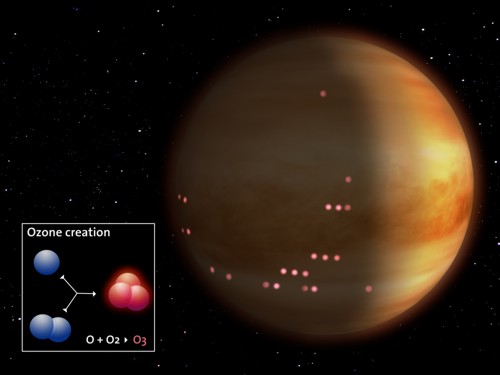Scientists Discover Ozone Layer On Venus

This story was updated at 2:16 p.m. EDT.
A European spacecraft has discovered an ozone layer high in the sweltering atmosphere of Venus, a new study reveals.
The discovery will help astronomers better understand the composition of Venus' murky atmosphere, and by comparing it to the atmospheres of Earth and Mars, the findings could even help shape the search for life on other planets, the researchers said.
The European Space Agency's Venus Express spacecraft detected ozone, which is a molecule containing three oxygen atoms, while gazing at stars that can be seen at the very edge of the planet through its atmosphere.
"This detection gives us an important constraint on understanding the chemistry of Venus's atmosphere," study leader Franck Montmessin, of the Laboratoire Atmosphères, Milieux, Observations Spatiales (LATMOS) in France, said in a statement.
Ozone layer on Venus
The probe's Spectroscopy for Investigation of Characteristics of the Atmosphere of Venus (SPICAV) scrutinized the starlight for key characteristics of gases in the atmosphere as it is absorbed at different wavelengths. The Venus Express SPICAV instrument discovered the ozone because it absorbed some of the ultraviolet light from the stars, the researchers said. [Amazing Photos of Venus]
Breaking space news, the latest updates on rocket launches, skywatching events and more!
The findings were presented Oct. 6 at the joint meeting of the European Planetary Science Congress and the American Astronomical Society's Division for Planetary Sciences in Nantes, France.
Computer models show that the ozone on Venus forms when sunlight breaks up carbon dioxide molecules, which releases oxygen atoms. Winds in the atmosphere of Venus sweep these atoms around to the night side of the planet, where they can combine to form two-atom oxygen molecules, as well as three-atom ozone molecules.
The discovery will help scientists better characterize the chemistry of Venus' atmosphere, but it could also be useful for astronomers searching for life on other worlds, the researchers said.
By comparing the properties of Venus' atmosphere with equivalent layers of the atmospheres of Earth and Mars, scientists could narrow down their search for life on other planets, Montmessin explained.
The research will be detailed in the November issue of the journal Icarus.
Ozone on other worlds
To date, ozone has only previously been found in the atmospheres of Earth and Mars. On Earth, it plays a critical role because it protects life on the planet by absorbing much of the sun's harmful ultraviolet rays. Furthermore, it is thought to have been generated by life itself, the researchers said. [The Strangest Alien Planets]
The exact reason for the buildup of oxygen in Earth's atmosphere 2.4 billion years ago is not entirely understood, the scientists said, but microbes that expelled oxygen as a waste gas likely played a role.
Like plants, this process continues to replenish Earth's oxygen and ozone. Some astrobiologists have pointed to this to suggest that the existence of carbon dioxide, oxygen and ozone in an atmosphere could be a key marker for life on a planet.
Using this as a guide, future telescopes could pinpoint planets around other stars to examine their potential habitability. But, it's important to note that the amount of ozone is a critical part of the recipe.
The small amount of ozone in Mars' atmosphere has not been generated by life, but rather it is the result of sunlight breaking up carbon dioxide molecules.
Similarly, Venus is thought to have built up its ozone by non-biological means. The ozone layer on Venus sits 62 miles (100 kilometers) above the planet's surface, which is roughly four times higher in the atmosphere compared to Earth, and is also a hundred to a thousand times less dense.
Astrobiologists have theorized that a planet's ozone concentration must be about 20 percent of Earth's value before life should be considered as a cause. The results of this new study line up with this theory, since Venus remains well below this threshold.
"This ozone detection tells us a lot about the circulation and the chemistry of Venus's atmosphere," Håkan Svedhem, a project scientist for the Venus Express mission at the European Space Agency, said in a statement. "Beyond that, it is yet more evidence of the fundamental similarity between the rocky planets, and shows the importance of studying Venus to understand them all."
Editor's note: This story has been corrected to reflect the correct density of Venus' ozone layer.
Follow SPACE.com for the latest in space science and exploration news on Twitter @Spacedotcom and on Facebook.

Space.com is the premier source of space exploration, innovation and astronomy news, chronicling (and celebrating) humanity's ongoing expansion across the final frontier. Originally founded in 1999, Space.com is, and always has been, the passion of writers and editors who are space fans and also trained journalists. Our current news team consists of Editor-in-Chief Tariq Malik; Editor Hanneke Weitering, Senior Space Writer Mike Wall; Senior Writer Meghan Bartels; Senior Writer Chelsea Gohd, Senior Writer Tereza Pultarova and Staff Writer Alexander Cox, focusing on e-commerce. Senior Producer Steve Spaleta oversees our space videos, with Diana Whitcroft as our Social Media Editor.

